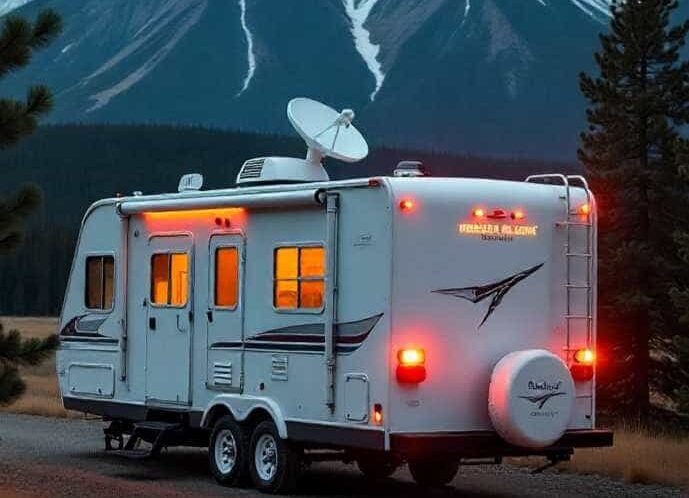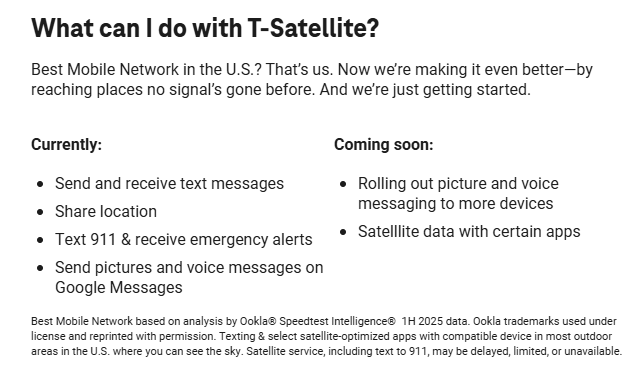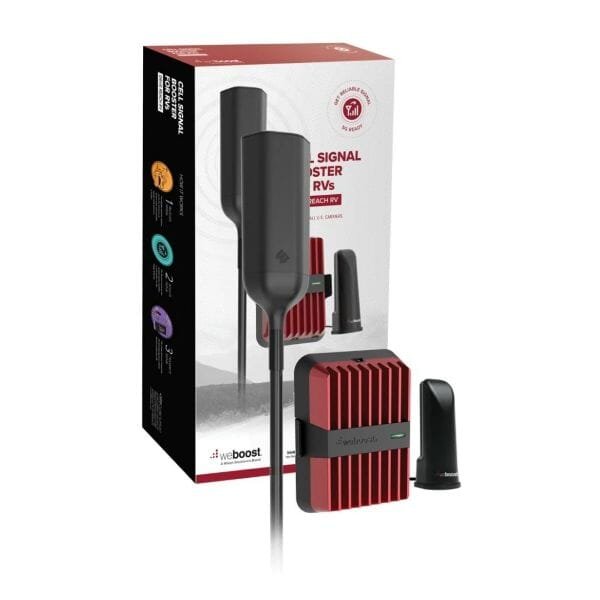Best RV Internet Options for Full-Time RVers
Introduction to RV Internet and TheRoadRoamers
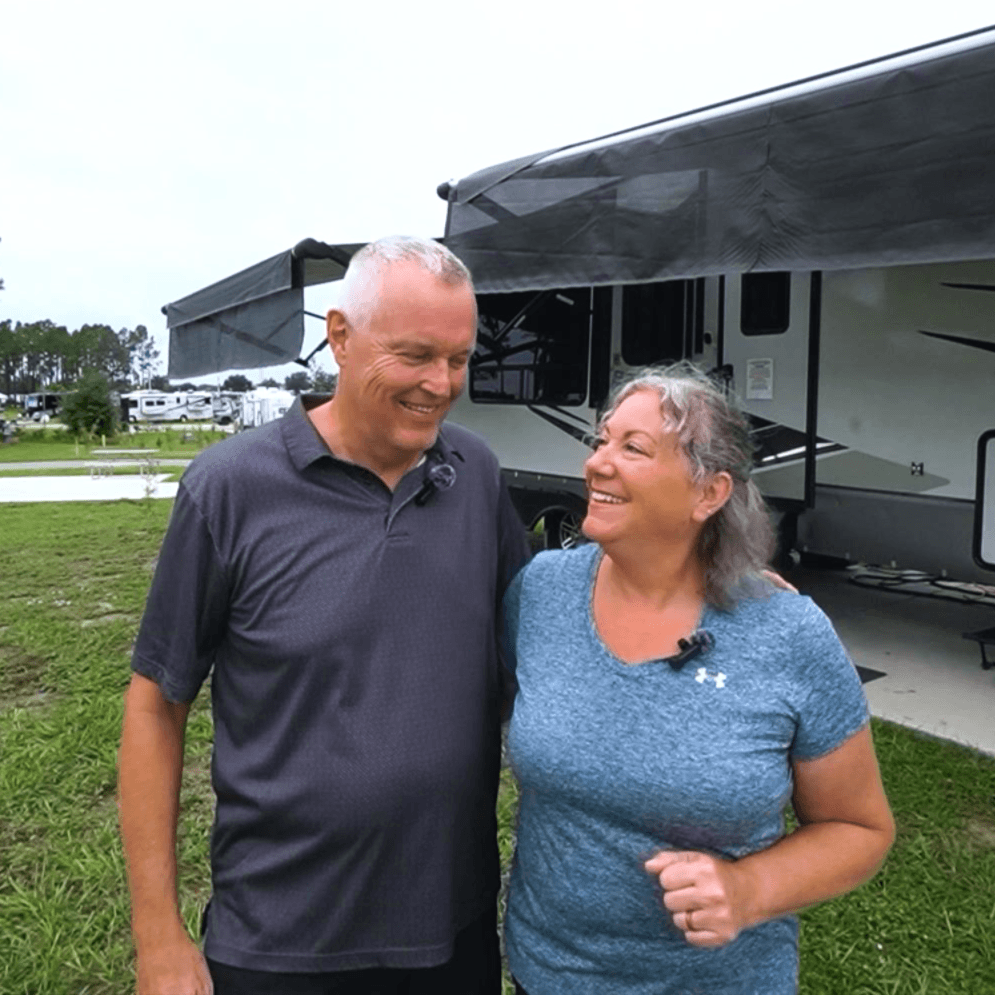
Hi, I’m Scott and my wife Amie and I, as some of you already know, are full time RVers and Digital Nomads. We are The Road Roamers and are known on YouTube for our content related to full time Rving and everything that goes along with it. I have always been kinda what you may call a “Tech Guy”. In car sales, for 17 years, I was always the “go too guy” for the other sale associates on questions retated too the many technical systems of today’s new cars, trucks, and SUVs. That’s why this post is right in my wheelhouse.
Remember, if you have any questions about full time RVing leave a comment below, and if we haven’t already, maybe we’ll make a new video to answer your questions!
In today’s digitally connected world, having reliable internet access while traveling in an RV has become increasingly important for full-time travelers. As RVers, we are always searching for the best RV internet for remote work. RV internet is not just a luxury; it is an essential tool that facilitates various aspects of life on the road, including productivity, communication, and entertainment. For “Digital Nomads” and remote workers, a stable internet connection is crucial for maintaining their work commitments, enabling them to operate efficiently from virtually anywhere.
The ability to connect to the internet while on the move allows RV travelers to seamlessly conduct business, attend virtual meetings, and collaborate with colleagues in real-time. This connectivity contributes significantly to their overall productivity, empowering them to manage their professional obligations without sacrificing their travel experiences. Additionally, reliable internet access enhances personal communication with family and friends, helping to bridge the distance and maintain relationships despite the geographic separation.
Moreover, the recreational value of internet connectivity cannot be overlooked. Full-time travelers often seek entertainment options such as streaming services, online gaming, and social media, which require stable internet connections. The growing demand for these services underscores the necessity for RVer’s to invest in effective internet solutions to enrich their lifestyle.
The surge of remote working and the need for constant connectivity among aspiring nomads signifies a shift in the way people view travel and work. As such, understanding the various options for RV internet has become an imperative for those who want to balance an adventurous lifestyle with their professional requirements. This guide aims to explore the different types of internet solutions available, catering to the needs of full-time travelers and ensuring they remain connected throughout their journeys.
Overview of RV Internet Options
Full-time travelers in recreational vehicles (RVs) often find themselves in need of reliable internet connections for work, communication, and entertainment. Fortunately, there are various options available that cater to diverse needs and preferences. Among these solutions, Starlink, mobile hotspots, signal boosters, and campground Wi-Fi stand out as popular choices for maintaining connectivity while on the road.
1) Starlink, offered by SpaceX, has gained a reputation for providing high-speed satellite internet in remote locations. This option, particularly suitable for those traveling to off-grid areas, utilizes a network of low Earth orbit satellites. As a result, users can expect improved latency and faster download speeds compared to traditional satellite internet services. Starlink is ideal for RV travelers who prioritize consistent connectivity while exploring less populated regions.
2) Mobile hotspots are another popular solution, particularly for individuals who rely on cellular networks. This option allows users to share their smartphone’s internet connection with multiple devices, or they can invest in dedicated hotspot devices that draw from cellular data plans. Mobile hotspots can vary in speed and coverage depending on the engaging provider and the strength of the cellular signal in a given area. This makes them a versatile choice for those navigating urban and suburban environments.
3) Signal boosters serve as an effective means to amplify weak cellular signals, especially in remote or rural areas where coverage may be spotty. By enhancing existing signals, these devices allow RV users to enjoy improved connectivity without changing their service plans. It is essential, however, to check compatibility with local networks to maximize performance.
4) Lastly, campground Wi-Fi can be a convenient option for transient travelers. Many campgrounds offer free or paid Wi-Fi services, which vary in reliability and speed. Understanding the limitations of campground Wi-Fi is crucial, as these networks can be congested or prone to disconnections during peak hours. By considering all of these options, RV travelers can find a suitable internet solution that meets their unique requirements.
Starlink: The Satellite Internet Solution
Starlink has emerged as a leading satellite internet service tailored to the needs of full-time travelers, particularly RV enthusiasts. Operating under SpaceX, this service is designed to provide high-speed internet connectivity in remote locations where traditional internet services may be unreliable or unavailable. One of the standout features of Starlink is its global coverage, making it an ideal choice for those who traverse diverse terrains across the country. Users can expect to access high-speed internet, often exceeding 100 Mbps, enabling them to stream, work remotely, or enjoy online gaming while on the road.

However, the transition to Starlink is not without its challenges. The initial investment in equipment can be significant, with costs rising into the hundreds of dollars. This upfront expenditure may deter some travelers; however, many users find that the benefits of stable internet during their journeys outweigh the initial outlay. Moreover, users report variability in service quality depending on their geographical location and proximity to the satellites, which can lead to potential latency concerns. In rural areas or densely wooded locations, connection speed may fluctuate, impacting the overall user experience.
User experiences with Starlink vary widely. For instance, an RVer traveling through the mountainous regions of the Pacific Northwest shared that having reliable internet transformed their travel experience, allowing them to maintain remote work seamlessly. Conversely, another user camping in a heavily forested area noted challenges with connectivity during certain times of the day, highlighting the need for potential users to assess their specific travel routes and expected service quality. Collectively, these anecdotes underscore the importance of evaluating personal needs and preferences when considering Starlink as an internet solution for RVing.
Mobile Hotspots: Flexibility and Coverage
Mobile hotspots have emerged as a favored solution for those seeking RV internet connectivity while on the road. Their primary appeal lies in the flexibility they offer, allowing full-time travelers to access the internet from virtually anywhere within a cellular network’s coverage area. Various providers offer tailored data plans that cater to the unique needs of RV users, emphasizing the importance of choosing the right plan to ensure seamless connectivity during travel.

When comparing mobile hotspot providers, options like Verizon, AT&T, and T-Mobile stand out due to their extensive coverage areas and diverse data plans. Verizon, for example, has a reputation for exceptional rural coverage, but recently, T-Mobile has added 650+ low orbit satellites, the largest satellite-to-mobile constellation, set up to keep you connected in places no carrier towers can reach. We personally have T-Mobile and we highly recommend using them. Below is what T-Mobile is claiming as of year 2025.
In addition, Android or iOS? Doesn’t matter. Works on 60+ phones with no apps required.
However, while mobile hotspots offer significant advantages, they are not without their limitations. Data caps frequently accompany mobile plans, potentially restricting usage, particularly for streaming services, large downloads, or frequent video conferencing. Users should carefully examine the data limits imposed by their selected plan to avoid unexpected overage charges. Additionally, service outages can occur, especially in less populated or rural areas where the cellular network may be weaker.
To optimize the performance of mobile hotspots, travelers may consider several strategies. Positioning the device near a window can improve signal strength, while utilizing a Wi-Fi booster can further enhance connectivity in challenging environments. Additionally, regularly checking for software updates ensures the device operates at optimal levels. By understanding both the advantages and limitations of mobile hotspots, full-time RV travelers can make informed decisions regarding their internet access needs.
Below is a screenshot of the speeds we are getting with just the T-Mobile towers in Orlando Florida.
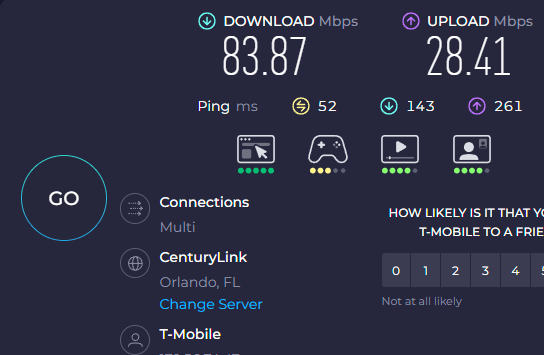
Signal Boosters: Enhancing Existing Connections
For full-time travelers utilizing recreational vehicles (RVs), maintaining a reliable internet connection is essential. Signal boosters have emerged as a crucial tool for enhancing existing cellular data or campground Wi-Fi connections. These devices capture weak signals from nearby towers or Wi-Fi hotspots and amplify them, providing a stronger and more stable internet connection. This enhancement can significantly improve the quality of connectivity in remote locations where internet options may be sparse or unreliable.
There are several types of signal boosters available on the market. Cellular signal boosters are commonly used to enhance mobile data and are designed to work with specific carriers. These boosters typically consist of three main components: an external antenna, an amplifier, and an internal antenna. The external antenna captures the cellular signal from afar, the amplifier strengthens it, and the internal antenna redistributes the boosted signal within the RV. On the other hand, Wi-Fi signal boosters are specifically designed to enhance the quality of campground Wi-Fi connections, allowing users to extend their range and improve their connectivity.
Installation of these boosters can vary based on the type and model chosen. Many signal boosters come with explicit instructions and require minimal tools for setup. Most devices can be installed in less than an hour; however, ensuring proper placement of the external antenna is vital for optimal performance. Boosters typically work best when there is a clear line of sight to the source of the signal.
The effectiveness of signal boosters is largely dependent on the strength of the original signal being captured. In areas where signals are particularly weak, the enhancements provided by a good booster can make a pronounced difference, allowing for smoother streaming, quicker loading times, and more stable connections for tasks like video calls and online gaming, which are particularly important for remote work and personal connections on the road.
Campground Wi-Fi: The Good, The Bad, and The Ugly
Campground Wi-Fi is often seen as a primary connectivity option for full-time RV travelers, offering an opportunity to stay connected without the need for additional mobile data plans. One of the advantages of campground Wi-Fi is its cost-effectiveness; many campgrounds provide this service complimentary or for a nominal fee. However, the quality of the connection can vary significantly between different campgrounds, leading to a mixed bag of experiences for users.
Travelers frequently report inconsistent internet speeds and unreliable connections when using campground Wi-Fi. Factors such as the number of users online, the bandwidth allocated to the service, and the infrastructure of the campground can all influence performance. Users may find themselves struggling with slow upload and download speeds, which can be particularly frustrating for those who rely on the internet for remote work or streaming services. Moreover, some campgrounds may impose restrictions on data usage, leading to further limitations on what can be accomplished online.
To maximize the benefits of campground Wi-Fi, there are several strategies users can employ. First, it is wise to connect during off-peak hours when fewer campers are likely to be online. This often occurs early in the morning or late at night. Additionally, setting up a signal booster or wi-fi extender can enhance connectivity quality, improving overall internet speed. It is also advisable to be cautious about security when using shared networks; employing a Virtual Private Network (VPN) can help protect personal information. Furthermore, downloading necessary content ahead of time, such as maps or entertainment, can alleviate the need for a stable connection at all times. By understanding these dynamics, RV travelers can navigate the nuances of campground Wi-Fi more effectively.
Comparative Analysis of Each Option
When it comes to securing reliable internet connection while traveling in an RV, several options stand out: Starlink, mobile hotspots, boosters, and campground Wi-Fi. Each of these choices exhibits distinct characteristics across various criteria—namely cost, speed, reliability, ease of use, and installation. Understanding these differences can facilitate informed decision-making for full-time travelers.

Cost: Starlink tends to have a higher initial investment due to the cost of equipment, roughly $599 for the dish and additional hardware, along with a monthly service fee of around $110. Mobile hotspots can be more budget-friendly, with devices ranging from $50 to $300 and monthly plans averaging $50 to $100, depending on data usage. Boosters generally require a one-time purchase of somewhere around $520 for a good one, while campground Wi-Fi might be free or included with a campsite fee, but may be less reliable.
Speed: Starlink offers impressive speeds, often exceeding 100 Mbps, making it suitable for streaming and video calls. Mobile hotspots can deliver speeds between 10 to 50 Mbps, contingent on the cellular network. Booster performance can vary widely based on existing signals but typically enhances speeds marginally. Campground Wi-Fi varies in speed, frequently ranging from 1 to 10 Mbps, and can be slow when multiple users are connected.
Reliability: Starlink provides robust connectivity regardless of location, especially in rural areas. Mobile hotspots depend heavily on cellular coverage, which may fluctuate in remote regions. Boosters can improve signal strength but do not guarantee consistent connectivity. Campground Wi-Fi is often unreliable, especially during peak usage times when many campers are online concurrently.
Ease of Use: Starlink setup is straightforward but requires proper location for optimal satellite access. Mobile hotspots are user-friendly, as they simply connect to cellular networks. Boosters may require installation, although many are designed for easy setup. Campground Wi-Fi typically necessitates a login process, adding to the complexity for travelers.
Installation: Starlink requires installation of the satellite dish, which can be cumbersome for some users. Mobile hotspots are generally plug-and-play. Boosters may involve mounting equipment, while campground Wi-Fi is usually ready to use upon arrival.
Overall, examining these key factors allows travelers to select the best internet solution tailored to their specific needs while enjoying life on the road.
Real-World Remote Work Tips for RVers
For full-time travelers and RV enthusiasts, working remotely while on the road presents unique challenges and opportunities. Successful remote work requires careful planning and commitment to organizational practices, particularly when it comes to optimizing your internet setup. To ensure a reliable connection, consider using a combination of hotspot devices, mobile Wi-Fi boosters, and local cellular plans. When choosing your internet provider, research coverage maps for the areas you plan to visit, as connectivity can vary significantly between locations.
Finding suitable working environments is crucial in maintaining focus. Look for campgrounds that offer dedicated workspaces or Wi-Fi access in their common areas. Alternatively, libraries and coffee shops often provide quiet settings with stable internet connections. Whenever possible, harmonize your work hours with off-peak times to minimize distractions. Be proactive in scouting locations ahead of time to secure the best spots. This practice not only enhances productivity but also ensures that you can adapt material to suit client needs on schedules aligned with time zone differences.
Managing distractions and creating a disciplined work-life balance is essential to thriving as a remote worker in an RV. Designate a specific workspace that allows you to separate professional tasks from personal leisurely activities. Consistent routines, such as established working hours, will also help you maintain a manageable balance between work and exploration. Remember to take regular breaks for exercise, leisure, and social interaction, as these are key to sustaining your mental wellness and productivity on the road. By implementing these practical tips, RVers can successfully blend their passion for travel with their professional responsibilities, establishing a fulfilling remote work experience that accommodates their lifestyle. Be sure to check out our Wealthy Affiliates Review-Digital Nomads where you can learn to build you own digital empire.
Choosing the Right Mobile Connectivity Setup

When it comes to selecting the most suitable mobile connectivity setup for full-time travelers in an RV, there are several crucial factors to consider. Understanding these aspects can help ensure you have a reliable internet connection that suits your travel lifestyle.
Firstly, assess the frequency of your travels. If you frequently move between locations, a mobile hotspot with national coverage may be ideal. This option can provide consistent service across various regions. Conversely, if your travels are more stationary, perhaps staying at a limited number of campgrounds for longer periods, you might consider the Wi-Fi range and availability of those locations. Some campsites offer free Wi-Fi, but reliability can vary, so it is essential to factor this into your decision.
Your intended destinations also play a significant role in determining the right setup. Rural areas may have limited cellular networks, making it advantageous to investigate providers known for extensive coverage in those regions. Researching ahead of time can save you from connectivity challenges down the road. Similarly, think about your data usage patterns; if you often stream videos or engage in online activities that require substantial data, it would be prudent to select a plan that offers higher data allowances.
Budget considerations are equally important in your decision-making process. Various options are available, ranging from basic plans to more premium packages with extensive features. It’s crucial to find a balance between cost and the level of service you require. Preparing a budget that aligns with your connectivity needs, travel habits, and preferred destinations will help you make an informed choice.
In summary, evaluating your travel frequency, destination types, data requirements, and budget can significantly direct your selection of a mobile connectivity setup. By considering these factors, you will be well-equipped to choose the right RV internet option for your full-time travel needs.
Here’s a little transparency: Our website contains affiliate links. This means if you click and make a purchase, we may receive a small commission. Don’t worry, there’s no extra cost to you. It’s a simple way you can support our mission to bring you quality RV related content. Best Regards, Scott
Please feel free to leave a comment below. Thanks for reading!

